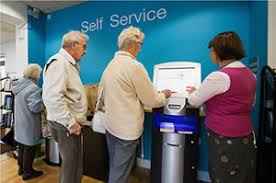
Guest author digital customer support and customer recovery expert Laurie Meacham
Have you ever thought about how polarizing technology is? It’s excellent when it makes our lives easier – in fact, we hardly even notice how easy it is when things work – and can cause a disproportionate amount of frustration when it doesn’t work, often because we get stuck.
When we talk about the people behind your tech, we’re not referring to engineers, designers or developers. As CX increasingly relies on technology, it’s even more important to inform, empower and educate the people your customers will come into contact with next when something goes wrong with your tech.
I had two recent experiences at restaurants where you order from a screen. The first experience was at an airport and all went well until I completed and paid for my order and then wanted to add on a drink. The touch screen froze and wouldn’t accept my payment. A server quickly showed up, tried to fix it and after a few unsuccessful seconds said, “Don’t worry about it. I’ll bring you the drink.” She seemed familiar with the system, even though she couldn’t reset it right then, and was sympathetic enough to the hassle that she didn’t make the experience any more difficult than it already was. Will I visit there again? Sure!
The second screen-order experience played out differently. I wanted to buy a gift card and had checked online first, hoping I could get an electronic one. The company website was easy to navigate and I quickly found that gift cards could be purchased “at any location.” When I got to a location, I found that the primary way to order was through a touch screen and gift cards weren’t an option from there. So I waited at the counter for a person. After several minutes, I wasn’t the only person waiting for a person. A system apparently designed for efficiency was resulting in a bottleneck of customers looking for someone to talk to. When an employee appeared, I let him know I’d like to buy a gift card. He hesitated, looked confused and said he’d need to ask a manager for help, but then he looked past me at the backlog of people and didn’t provide any sort of expectation (Was he going to ask someone? Would it
There’s often a disconnect between the virtual experience and the people experience, but if your people understand what your customers are experiencing, they can help them better.
How to close the gap:
- Encourage your people to take a trip through your customer’s experience. Let them experience the order screens and other virtual touch points.
- Take a tour of your website from a customer’s point of view, including the interactive parts
- If you have an IVR, have your people call in and navigate the menu
- Empower your people to make decisions and know what to do when things go wrong. They may not always be able to fix the actual issue, but they can help customers feel better about the situation by showing patience, kindness, and empathy
Relatability and a smile can go a long way toward improving a technical issue and the overall customer experience. You may hope that your customers rarely have to ask a person for help, but when they do, they should remember the simple fact that they’re one person talking to another.
Laurie is a communicator and leader with extensive experience in customer support through written and verbal communication. Currently leading a renown Social Media, Customer Commitment and Corporate Recovery Specialist Teams with a focus on cross-departmental collaboration and social media strategy. See her on LinkedIn at https://www.linkedin.com/in/lmeacham/






What is being talked about…